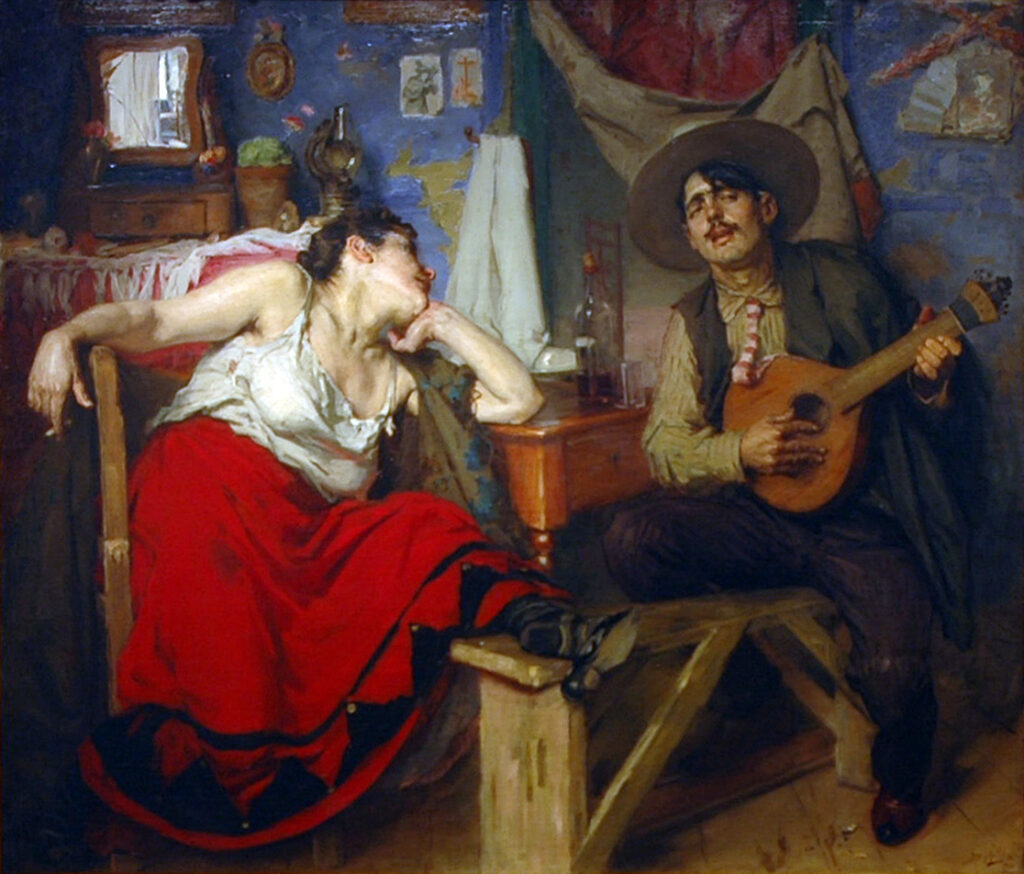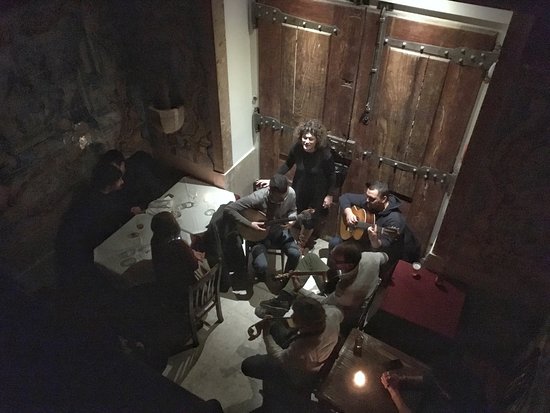Let me get this out of the way from the start. Just as no native Portuguese would rhyme Chiado with ‘shadow’, neither would they rhyme fado with the first note of the musical scale. Rather, they would pronounce it more like this:
But I’m an American who will stretch an opportunity for a pun to its limits. With that said, I think it would be a sin of omission to visit Portugal without attending at least one fado show.
If a single word, saudade, can, as many say, capture the temperament of a nation then no single style of music captures that feeling more than fado. Saudade is a feeling of melancholy, longing, and nostalgia. The etymological root of the word fado is the Latin fatum meaning fate. Unlike the word, the roots of the music are somewhat mysterious. Here’s Rafael Carvalho, expressing Saudade on a viola da terra from the Azores.
A distinction with a difference
This section’s header is both academic and more than academic. Fado exists in two distinct styles – one that has its roots in the streets and alleys of Lisbon and one that developed afterward in the university town of Coimbra. Coimbra fado is strongly linked to academia while in Lisbon – where fado was truly born – it is more closely tied to legend.
Fado was first heard in the streets of working class neighborhoods in Lisbon – primarily Alfama and Mouraria but also in Alcântara, Bairro Alto, Baixa, and Madragoa – in the early decades of the nineteenth century.
Lyrically, these early fado songs expressed sadness and longing for lost dreams or unmet desires, lost and unfulfilled loves, or sometimes a yearning for home. Musically, some believe that the drawn-out laments originated in Mouraria – the neighborhood to which the Moors were consigned after the Reconquista. Others say some of the basic elements are found in the music from enslaved Africans in Brazil and still others claim it evolved from the hearts of Portuguese sailors dreaming of home during their long sea voyages. It’s likely some combination of these mixed with other unenumerated elements because that’s how life and art works.
In nineteenth century, the music was sung in “fado houses” which were generally taverns on the first floor and brothels on the upper floors. Fado was unquestionably the music of and sung by prostitutes and sailors who not only sang themselves but often accompanied the women as they sang.

(José Malhoa – O Fado – Wikimedia Commons Public Domain)
How then, did fado gain the respectability with the bourgeoisie and aristocracy that would take it from the brothels of Alfama and Mouraria to the university in Coimbra 200 kilometers to the north? Here, the legendary credit belongs to a prostitute and fadista named Maria Severa Onofriana known simply as Severa.
There are few contemporary descriptions of her but she’s said to have been an exotic beauty with “magnificent peninsular eyes” and a dramatic singing style that captivated nearly everyone but especially captivated men. This unfinished portrait sketched by Francisco Metrass is the only contemporary likeness.

(Wikimedia Commons – Public Domain)
One of those captivated (captive?) men was D. Francisco de Paula de Portugal e Castro, Count of Vimioso. The count regularly took Severa to bullfights, installed her in a modest flat in Bairro Alto, and had her perform at his home. This exposure by the “mezzo-soprano from the conservatories of vice” allowed others among the elite to embrace the music and it was their sons who then carried it to Coimbra.
Severa died from tuberculosis at age 26. Today, when they perform, most female fadistas wear a black shawl to symbolically honor Severa. Here’s a video of Amália Rodrigues – perhaps the most famous fadista of the twentieth century – singing Severa’s New Fado written by Frederico De Freitas and Júlio Dantas (Dantas also wrote a novel about her called A Severa.).
From Coimbra to UNESCO
While the Lisbon style of fado retains much of its original character, for some it has been overly democratized and popularized – particularly regarding the expansion of the lyrical subject matter. Once it reached the university at Coimbra, the sons of the bourgeoisie and aristocracy likely felt a bit sheepish performing music from the ‘conservatories of vice’ and they brought some notable changes to the music’s character.
Coimbra fado is played and sung exclusively by men who often dress in a traditional academic outfit of a dark robe, cape, and leggings. Some suggest the roots of this style are drawn from the medieval troubadour and it was certainly not uncommon to find singers who organized serenades to sing beneath the windows of women they were courting.
The viola da terra (above) is one of two instruments you will see in any fado performance style – whether Coimbra or Lisbon. The other is the Portuguese guitar – sometimes called the fado guitar. However, the Coimbra guitar is different from the the Portuguese guitar. Wikipedia delineates them:
The differences between the two models are the scale length (445 mm of free string length in Lisboa guitars and 470 mm in Coimbra guitars), body measurements, and other finer construction details. Overall, the Coimbra model is of simpler construction than the Lisboa model. Visually and most distinctively, the Lisboa model can easily be differentiated from the Coimbra model by its larger soundboard and the scroll ornament (caracois – snail) that usually adorns the tuning machine, in place of Coimbra’s teardrop-shaped (lagrima) motif. Lisboa guitars usually employ a narrower neck profile as well. Both models have a very distinct timbre, the Lisboa model having a more bright and resonant sound…
The subject matter for Lisbon fado has broadened to the point where nearly any topic is acceptable. In Coimbra, the songs must express feelings of love, life, friendship, affection, and saudade, “in the way a man writes a letter to his lover, a friend confesses his admiration for friendship, or the way a student from Coimbra longs for this mystical city” wrote one critic.
In 2011, UNESCO added fado to its list of World’s Intangible Cultural Heritage. Whether that should include and embrace both the Lisbon and Coimbra styles is a matter of debate even among some Portuguese.
Mesa de Frades
Early in this post I noted that I’d consider visiting Portugal without taking in at least one fado show a sin of omission. However, as I poked around the world wide web preparing for this trip it became clear to me that, as is the case with many bits of intangible cultural heritage, finding authenticity can be tricky so I left it to the folks at Portugal Trails to book a show for me. The restaurant they chose was Mesa de Frades in Alfama. Here’s how AFAR travel guide describes it,
…the fado houses of Bairro Alto and the Alfama can be complete tourist traps. Keep on walking to Mesa de Frades, an 18th-century chapel lined with exquisite Portuguese tiles, where just a few intimate tables are up for grabs each night. Be sure to make a reservation, and a late one at that—locals tend to go after midnight.
My dinner reservation at 20:00 wasn’t too late and I arrived a bit early. A young woman who was at the door in front of me was being rebuffed by the owner in her request for an available table. I immediately invited her to join me since a table for one can always accommodate a second person. The owner was willing to oblige with the understanding that my evening had been prepaid and hers wouldn’t be.
Francesca was nearing 40, from Taiwan (or as she sometimes called it Formosa), and was in Lisbon on business. She works as a sales rep for an online gaming company. In addition to general conversation, I told her what I’d learned from Ana about what to expect and how to behave. The show would start sometime between 21:00 and 22:00 after all the dinner courses had been served. The singers would perform short sets of three to four songs and one should only leave between sets because to do otherwise is exceptionally rude to the performers. (At Mesa de Frades, leaving during a set is impossible as you can see in this photo from Trip Advisor.

At about 23:00 after four sets of songs, I was beginning to fade. It had been a long day and I had a lot of walking in my plans for Thursday. Although, I’d indicated otherwise at the door, I paid for Francesca’s dinner (a bit of paying it in some direction for my earlier good fortune) and invited her to stay as long as she liked as I took my leave.
I walked down the hill, rode the Metro back to the Avenida stop near the hotel, and after a two minute walk, collapsed into bed for a sound night’s sleep.